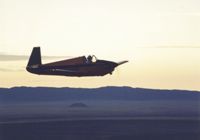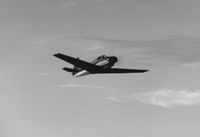 Most pilots know Mooney airplanes for a few infamous traits. The first word that comes to mind is “Tight;” Mooneys aren’t known for their spaciousness. But right behind tight, people think “Fast;” pound for pound, Mooney Aircraft Corporation holds the boasting rights in that category. Next in line is “Economical;” Al Mooney set out to design the bare minimum in an airplane. The Mooney Mite fits the bill perfectly. Just large enough to hold a pilot, the Mite, equipped with a 65hp Lycoming O-145, boasts a cruise speed of 122mph at 3 gallons per hour. Most pilots know Mooney airplanes for a few infamous traits. The first word that comes to mind is “Tight;” Mooneys aren’t known for their spaciousness. But right behind tight, people think “Fast;” pound for pound, Mooney Aircraft Corporation holds the boasting rights in that category. Next in line is “Economical;” Al Mooney set out to design the bare minimum in an airplane. The Mooney Mite fits the bill perfectly. Just large enough to hold a pilot, the Mite, equipped with a 65hp Lycoming O-145, boasts a cruise speed of 122mph at 3 gallons per hour.
At the end of World War II, general aviation manufacturers were looking for a new aircraft market. Several companies toyed with the idea of a single place, low wing aircraft. Piper built two prototypes of the PA-8, “Skycycle,” with the fuselage formed from surplus droppable fuel tanks used on the F-4U Corsair Fighter. The small craft proved overly expensive to produce and too difficult to handle for a general aviation aircraft. The market also appealed to Lockheed, who developed the Model 33, “Little Dipper.” The idea was scrapped after the prototype stage because of the large number of surplus military training aircraft available at very low prices. Luscombe also acted on the concept. The Model 10 prototype, constructed mainly of modified components from the standard production Luscombe Model 8A, proved to be a solid flyer. Surveys indicated the market would be too small for production, however. As a result, the Mooney Mite was the only single place general aviation aircraft to go into production after World War II.
 When Al Mooney founded Mooney Aircraft Company at Wichita Municipal Airport in 1946, his concept was to build the most efficient, least expensive single-engine airplane possible. Based heavily on designs he created for the PQ-8 and PQ-14 military drones during his tenure as Chief Engineer for Culver Aircraft Corporation, the Mooney M-18L—a.k.a. the “Mite”—met Al’s specifications. When Al Mooney founded Mooney Aircraft Company at Wichita Municipal Airport in 1946, his concept was to build the most efficient, least expensive single-engine airplane possible. Based heavily on designs he created for the PQ-8 and PQ-14 military drones during his tenure as Chief Engineer for Culver Aircraft Corporation, the Mooney M-18L—a.k.a. the “Mite”—met Al’s specifications.
Production began late in 1947 with an innovative, trailing link landing gear and a 25hp, liquid-cooled Crosley “Cobra“ Auto Engine. The plane, however, proved to be underpowered. Mooney quickly switched to the readily available 65hp Lycoming engine and retrofitted the seven previously delivered Mites at no cost to the customers. Fun and economical to fly, the Mite became increasingly popular and production was stepped up to meet the growing demand.
 As the Korean conflict came onto the world stage, aircraft workers in Wichita became increasingly scarce and expensive for general aviation companies. In an effort to stabilize his cash flow, Al Mooney approached the Army with the idea of a light ground support aircraft with hard points on the wings for weapons. The M-19, a beefed-up M-18 with a 90hp Continental engine, was approved by the Army, but the idea was “shot down” by the Air Force, defeating Mooney’s plans. The Air Force further complicated things for Mooney when they took over Wichita Municipal Airport and converted it into McConnell Air Force Base. After producing 239 Mites, Mooney Aircraft Corporation would have to look for a new home. As the Korean conflict came onto the world stage, aircraft workers in Wichita became increasingly scarce and expensive for general aviation companies. In an effort to stabilize his cash flow, Al Mooney approached the Army with the idea of a light ground support aircraft with hard points on the wings for weapons. The M-19, a beefed-up M-18 with a 90hp Continental engine, was approved by the Army, but the idea was “shot down” by the Air Force, defeating Mooney’s plans. The Air Force further complicated things for Mooney when they took over Wichita Municipal Airport and converted it into McConnell Air Force Base. After producing 239 Mites, Mooney Aircraft Corporation would have to look for a new home.
The answer came from Kerrville, Texas. In need of industry, Kerrville offered Mooney the airport with a ninety-nine year lease at one dollar per year. This, combined with the availability of trainable workers in the area, was a perfect opportunity for the small aircraft company and the community. Mooney moved to Kerrville in 1953. With this new start, Mooney began to look at expanding its aircraft line to include a four place single. The engineering department devoted all of their resources to the development of the M-20, basing the concept on the same principals that led to the M-18. The M-20 was a fast, economical aircraft, just large enough to hold four people.
 Things changed again for Mooney when Al’s partner, Charles Yankey, died in December, 1953. Without Charles’ backing, Mooney Aircraft corporation was broke. Additional partners were brought on board, but the deal wasn’t favorable to Al Mooney. In September, 1955, Al left Mooney Aircraft Corporation. With fewer pilots wanting to fly solo—and with the price of a new Mite less attractive due to increased material and labor costs—production of the M-18 stopped that same year. Things changed again for Mooney when Al’s partner, Charles Yankey, died in December, 1953. Without Charles’ backing, Mooney Aircraft corporation was broke. Additional partners were brought on board, but the deal wasn’t favorable to Al Mooney. In September, 1955, Al left Mooney Aircraft Corporation. With fewer pilots wanting to fly solo—and with the price of a new Mite less attractive due to increased material and labor costs—production of the M-18 stopped that same year.
During an eight year period, from 1947 to 1955, 283 M-18s were produced by Mooney Aircraft Corporation. Serial number 136 presently belongs to Mr. George Meenach, who has enjoyed owning her for a little over a year. His 1953 M-18LA came standard with a 65HP O-145 Lycoming engine.
 When asked if he painted the distinctive Big Dipper graphic on his plane’s tail, he laughed and replied, “No, that was done by a doctor up in Anchorage, Alaska. But it sure seems to draw a crowd whenever I fly into an airshow or event of some kind.” When asked if he painted the distinctive Big Dipper graphic on his plane’s tail, he laughed and replied, “No, that was done by a doctor up in Anchorage, Alaska. But it sure seems to draw a crowd whenever I fly into an airshow or event of some kind.”
Meenach loves his Mooney Mite, and he flies her every time he gets a chance. He also owns a 1946 Funk, which he refers to as his “family plane.” By contrast, the Mite is his little sports car with a maximum speed of 138 MPH.
“I’ve been flying since 1962,” Meenach said. And of all the planes he has flown and owned, flying the Mite is the most enjoyable, in no small part because, with a fuel burning rate of 3 gallons per hour, “it’s almost like flying for free.” No argument here.
If you’re in the Los Lunas, NM, area, George says feel free to call him. He’s usually around—if he’s not out flying. He’s always happy to talk airplanes and keeps a fresh pot of coffee brewing in the hangar. You can contact George at 505-865-8962.
Mooney 18LA Specs:
Span: 26 ft., 10.5 inches
Length: 17 ft., 7.25 inches
Height: 6 ft., 2.5 inches
Weight Empty: 520 lb.
Disposable Load: 260 lb.
Weight Loaded: 780 lb.
Wing Loading: 8.2 lb./sq. ft.
Power Loading: 12 lb./HP
Rate of climb: 1,090 ft./min
Service ceiling: 19,400 ft.
Maximum Range: 440 miles
Take-off run: 290 ft.
Max Speed: 138 MPH
Cruise Speed: 122 MPH
Stall Speed: 45 MPH
Stall Speed (flaps): 40 MPH
Never Exceed Speed: 143 MPH
Normal Operating Range: 50 to 114 MPH
Flap Operating Range: 45 to 85 MPH
Maximum Gear Operating Speed: 109 MPH
Maximum Hatch Open Speed: 109 MPH
Maneuvering Speed: 107 MPH
Type: Single-seat, light monoplane
Wings: Low-wing cantilever. Single spruce and plywood D-spar structure with fabric covering aft of spar. Ailerons and flaps have welded steel-tube frames and fabric covering. Gross wing area is 95 sq. ft.
Fuselage: Front section to back of pilot’s cockpit of welded steel tube with sheet aluminum-alloy covering. Rear section is a wood monocoque.
Tail Unit: Cantilever monoplane. End of fuselage hinged beneath leading-edge of tailplane for trim.
Landing Gear: Retractable Tricycle.
Power Plant: One 65 horsepower Lycoming O-145-B2 four cylinder, horizontally opposed air-cooled engine driving a two-blade, fixed-pitch Sensenich wood airscrew.
Fuel Tank: (11 US Gallons) In fuselage.
Accommodation: Single-seat cockpit with sliding canopy. Standard three-control system with stick and rudder pedals. Interconnected flaps and tail trim. |

